fog light TOYOTA CAMRY 2011 XV50 / 9.G Owners Manual
[x] Cancel search | Manufacturer: TOYOTA, Model Year: 2011, Model line: CAMRY, Model: TOYOTA CAMRY 2011 XV50 / 9.GPages: 554, PDF Size: 9.69 MB
Page 3 of 554

1
2
3
4
5
6
7
3
2-3. Operating the lights and wipers
Headlight switch .................. 162
Fog light switch ................... 167
Windshield wipers and washer .............................. 168
2-4. Using other driving systems
Cruise control ...................... 170
Driving assist systems ........ 174
2-5. Driving information Cargo and luggage ............. 179
Vehicle load limits ............... 182
Winter driving tips ............... 183
Trailer towing ...................... 187
Dinghy towing (automatic transmission) .................... 195
Dinghy towing (manual transmission) .................... 196 3-1. Using the air conditioning
system and defogger
Automatic air conditioning system.......... 200
Manual air conditioning system .............................. 208
Rear window and outside rear view mirror
defoggers ......................... 214
3-2. Using the audio system Audio system types ............ 216
Using the radio ................... 220
Using the CD player ........... 228
Playing MP3 and WMA discs ....................... 236
Operating an iPod .............. 244
Operating a USB memory ............................ 251
Optimal use of the audio system .............................. 258
Using the AUX port............. 263
Using the steering wheel audio switches ....... 265
3Interior features
Page 8 of 554
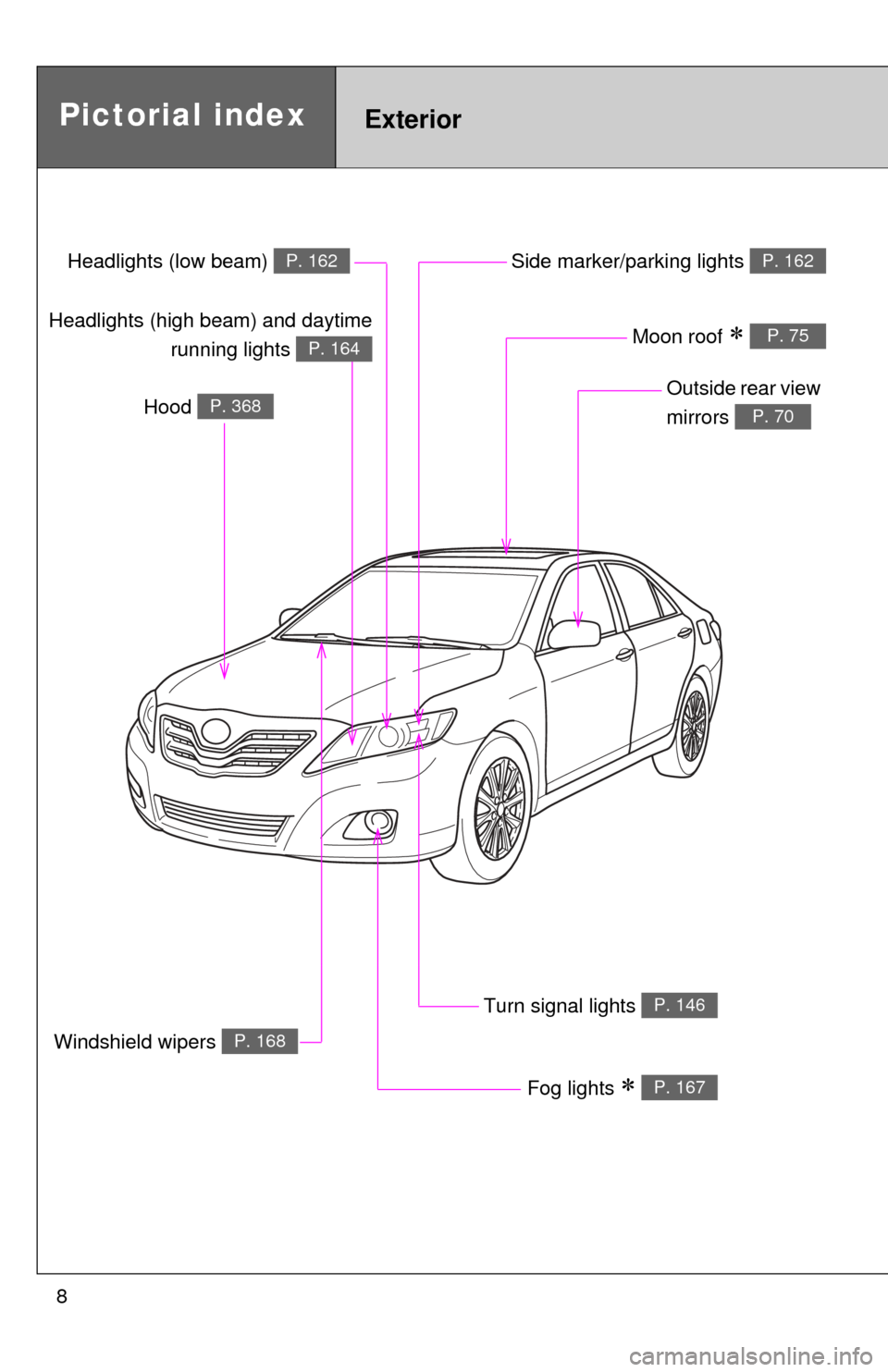
8
Headlights (low beam) P. 162
Pictorial indexExterior
Fog lights P. 167
Turn signal lights P. 146
Hood P. 368
Windshield wipers P. 168
Outside rear view
mirrors
P. 70
Side marker/parking lights P. 162
Moon roof P. 75Headlights (high beam) and daytimerunning lights
P. 164
Page 9 of 554
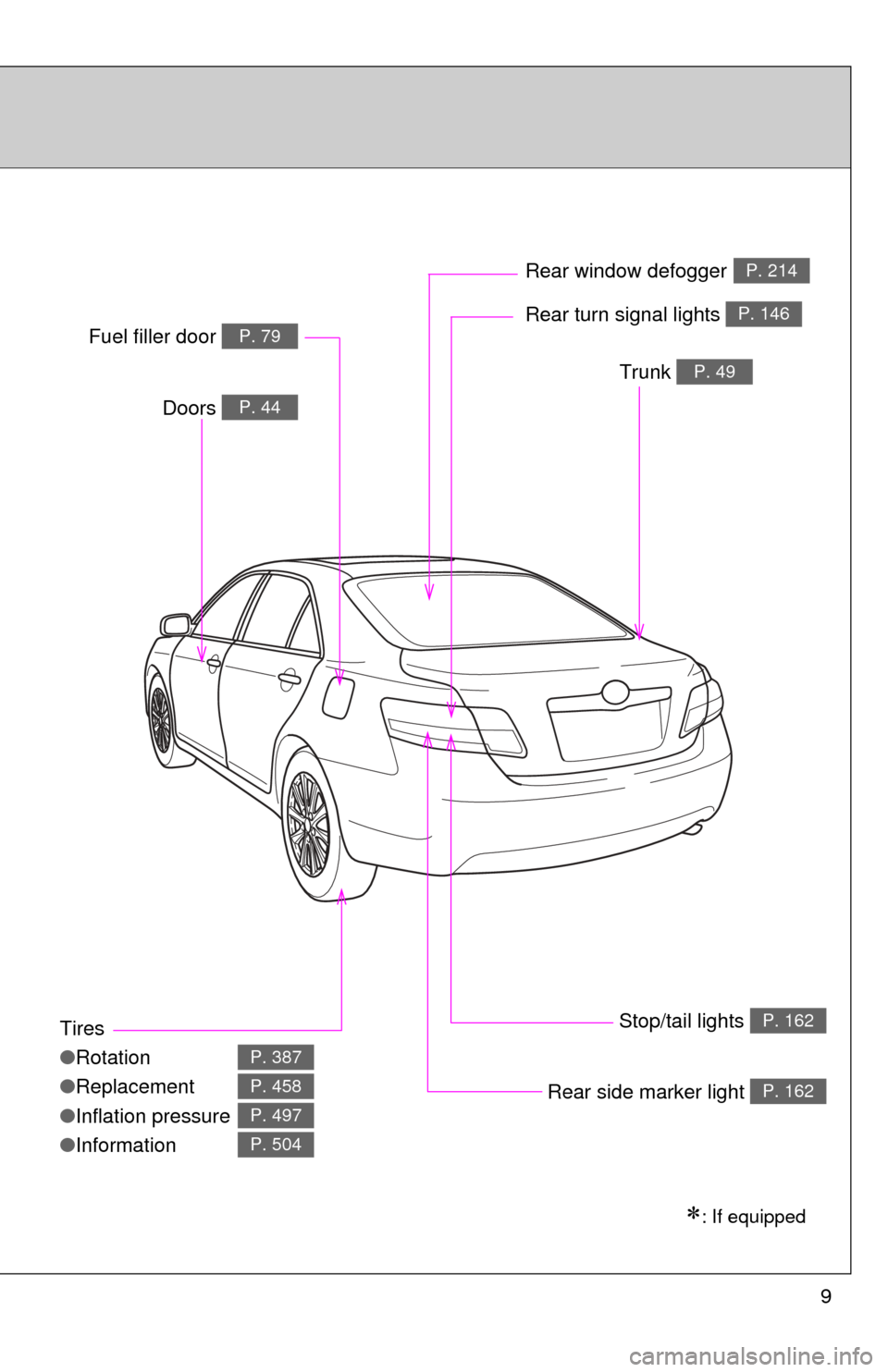
9
Tires
●Rotation
● Replacement
● Inflation pressure
● Information
P. 387
P. 458
P. 497
P. 504
Trunk P. 49
Doors P. 44
Fuel filler door P. 79Rear turn signal lights P. 146
Rear window defoggerP. 214
Stop/tail lights P. 162
: If equipped
Rear side marker light P. 162
Page 15 of 554
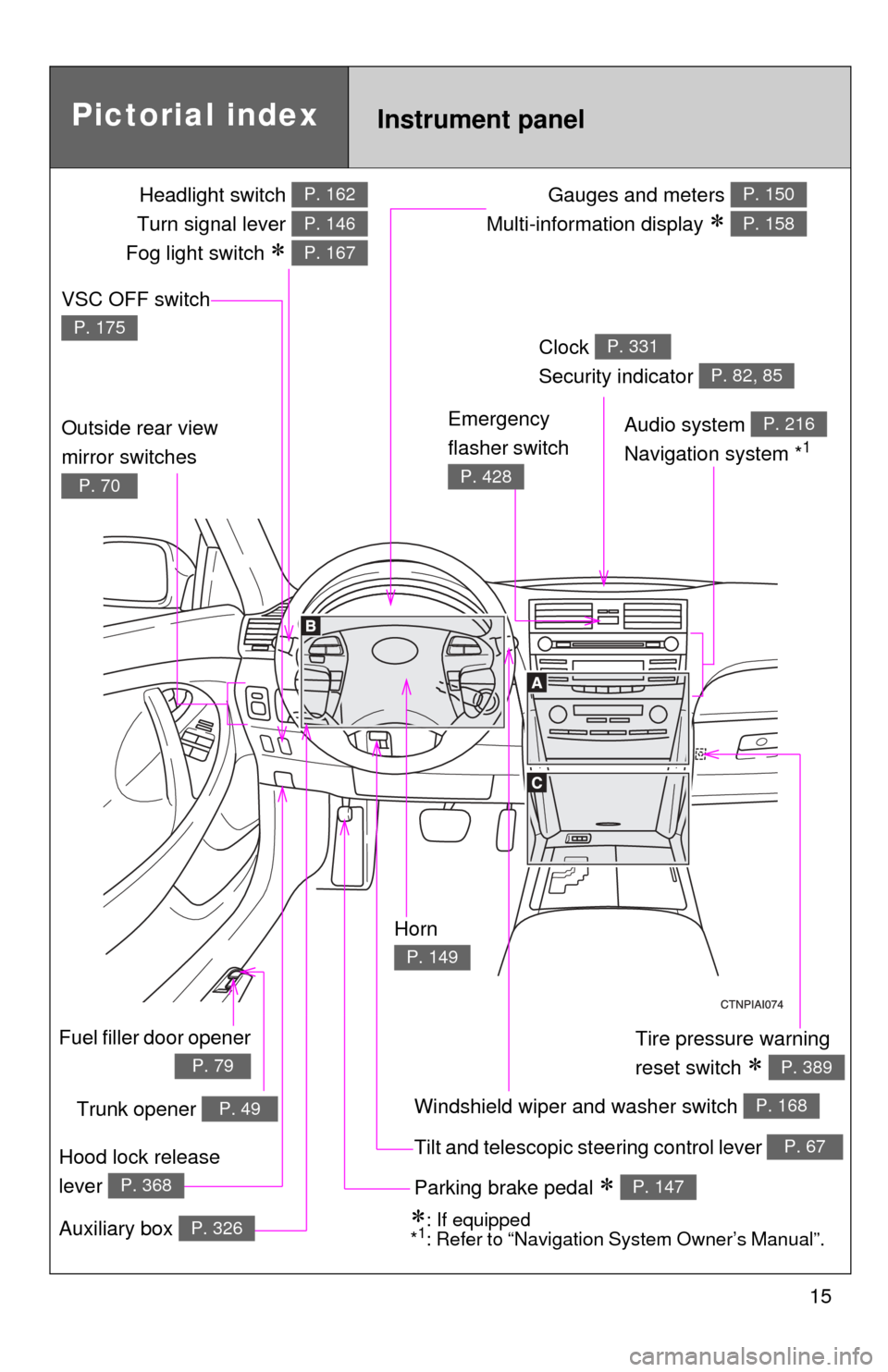
15
Gauges and meters
Multi-information display
P. 150
P. 158
Tilt and telescopic steering control lever P. 67
Pictorial index
Trunk opener P. 49
Headlight switch
Turn signal lever
Fog light switch
P. 162
P. 146
P. 167
Instrument panel
Audio system
Navigation system *1
P. 216
Windshield wiper and washer switch P. 168
Clock
Security indicator P. 331
P. 82, 85
Outside rear view
mirror switches
P. 70
Tire pressure warning
reset switch
P. 389
Parking brake pedal P. 147
Hood lock release
lever
P. 368
Fuel filler door opener
P. 79
Auxiliary box P. 326: If equipped
*1: Refer to “Navigation System Owner’s Manual”.
Emergency
flasher switch
P. 428
VSC OFF switch
P. 175
Horn
P. 149
Page 121 of 554
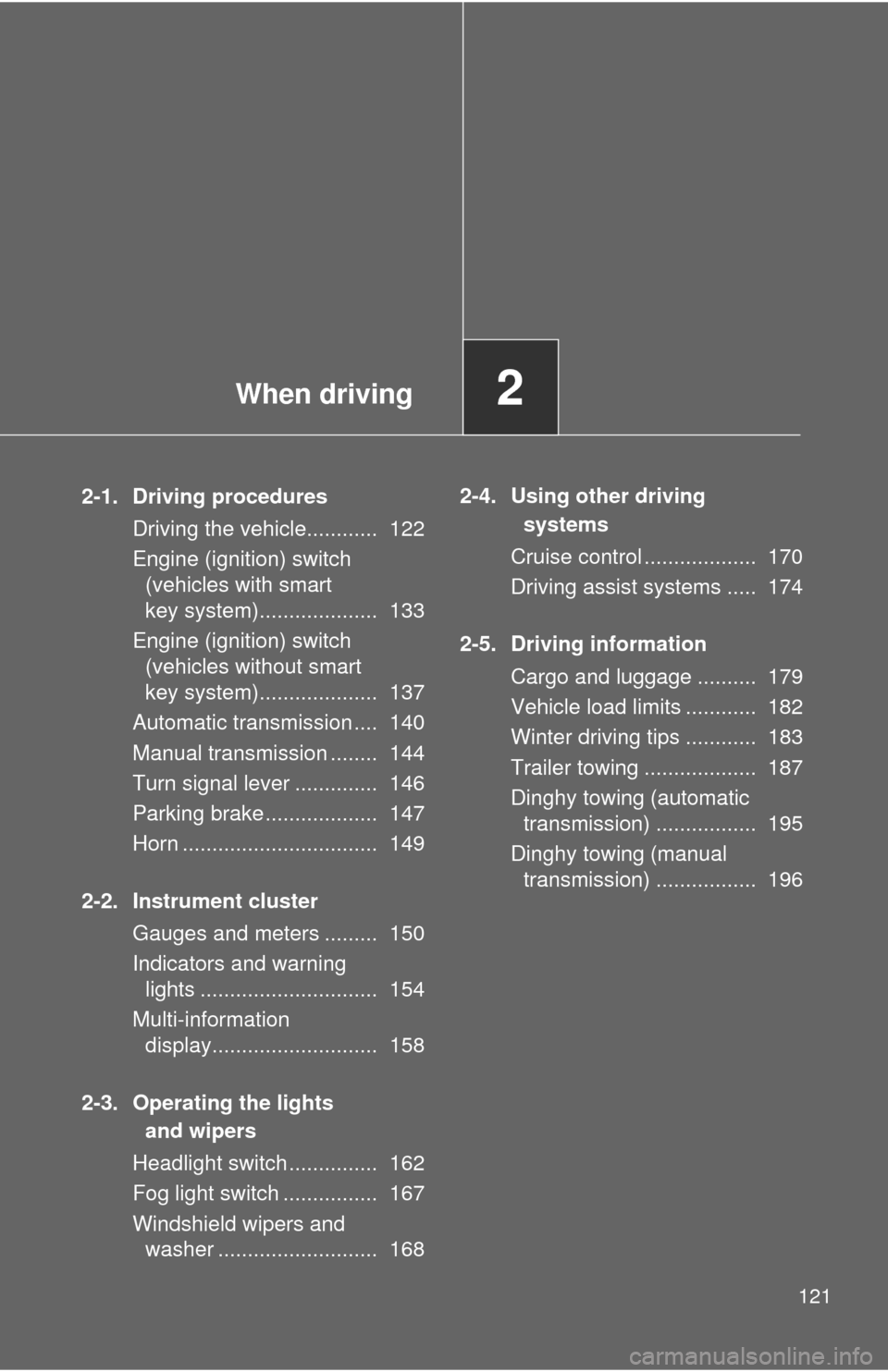
When driving2
121
2-1. Driving proceduresDriving the vehicle............ 122
Engine (ignition) switch (vehicles with smart
key system).................... 133
Engine (ignition) switch (vehicles without smart
key system).................... 137
Automatic transmission .... 140
Manual transmission ........ 144
Turn signal lever .............. 146
Parking brake ................... 147
Horn ................................. 149
2-2. Instrument cluster Gauges and meters ......... 150
Indicators and warning lights .............................. 154
Multi-information display............................ 158
2-3. Operating the lights and wipers
Headlight switch ............... 162
Fog light switch ................ 167
Windshield wipers and washer ........................... 168 2-4. Using other driving
systems
Cruise control ................... 170
Driving assist systems ..... 174
2-5. Driving information Cargo and luggage .......... 179
Vehicle load limits ............ 182
Winter driving tips ............ 183
Trailer towing ................... 187
Dinghy towing (automatic transmission) ................. 195
Dinghy towing (manual transmission) ................. 196
Page 124 of 554
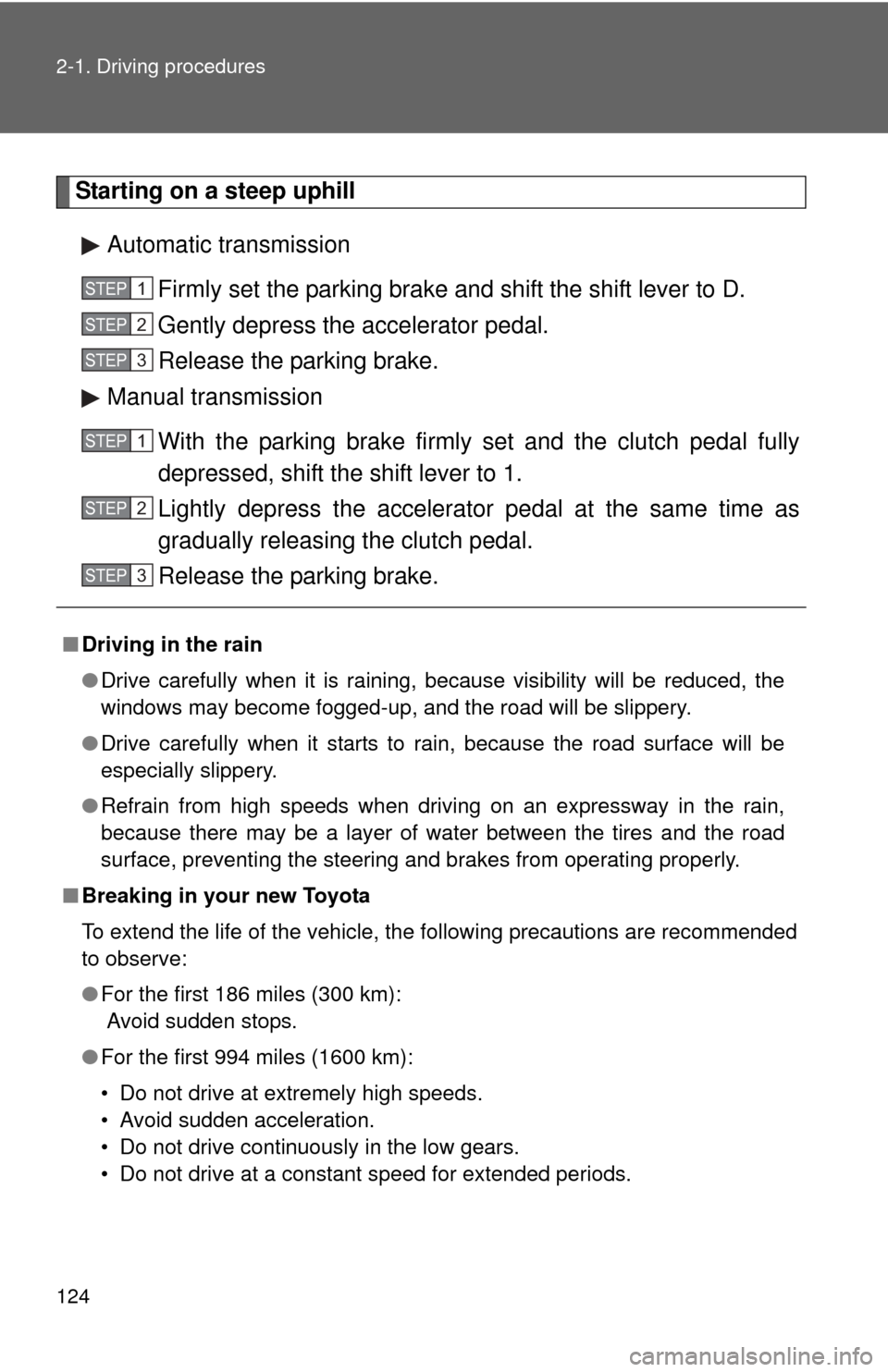
124 2-1. Driving procedures
Starting on a steep uphillAutomatic transmission Firmly set the parking brake and shift the shift lever to D.
Gently depress the accelerator pedal.
Release the parking brake.
Manual transmission
With the parking brake firmly set and the clutch pedal fully
depressed, shift the shift lever to 1.
Lightly depress the accelerator pedal at the same time as
gradually releasing the clutch pedal.
Release the parking brake.
■Driving in the rain
●Drive carefully when it is raining, because visibility will be reduced, the
windows may become fogged-up, and the road will be slippery.
● Drive carefully when it starts to rain, because the road surface will be
especially slippery.
● Refrain from high speeds when driving on an expressway in the rain,
because there may be a layer of water between the tires and the road
surface, preventing the steering and brakes from operating properly.
■ Breaking in your new Toyota
To extend the life of the vehicle, the following precautions are recommended
to observe:
●For the first 186 miles (300 km):
Avoid sudden stops.
● For the first 994 miles (1600 km):
• Do not drive at extremely high speeds.
• Avoid sudden acceleration.
• Do not drive continuously in the low gears.
• Do not drive at a constant speed for extended periods.
STEP1
STEP2
STEP3
STEP1
STEP2
STEP3
Page 156 of 554
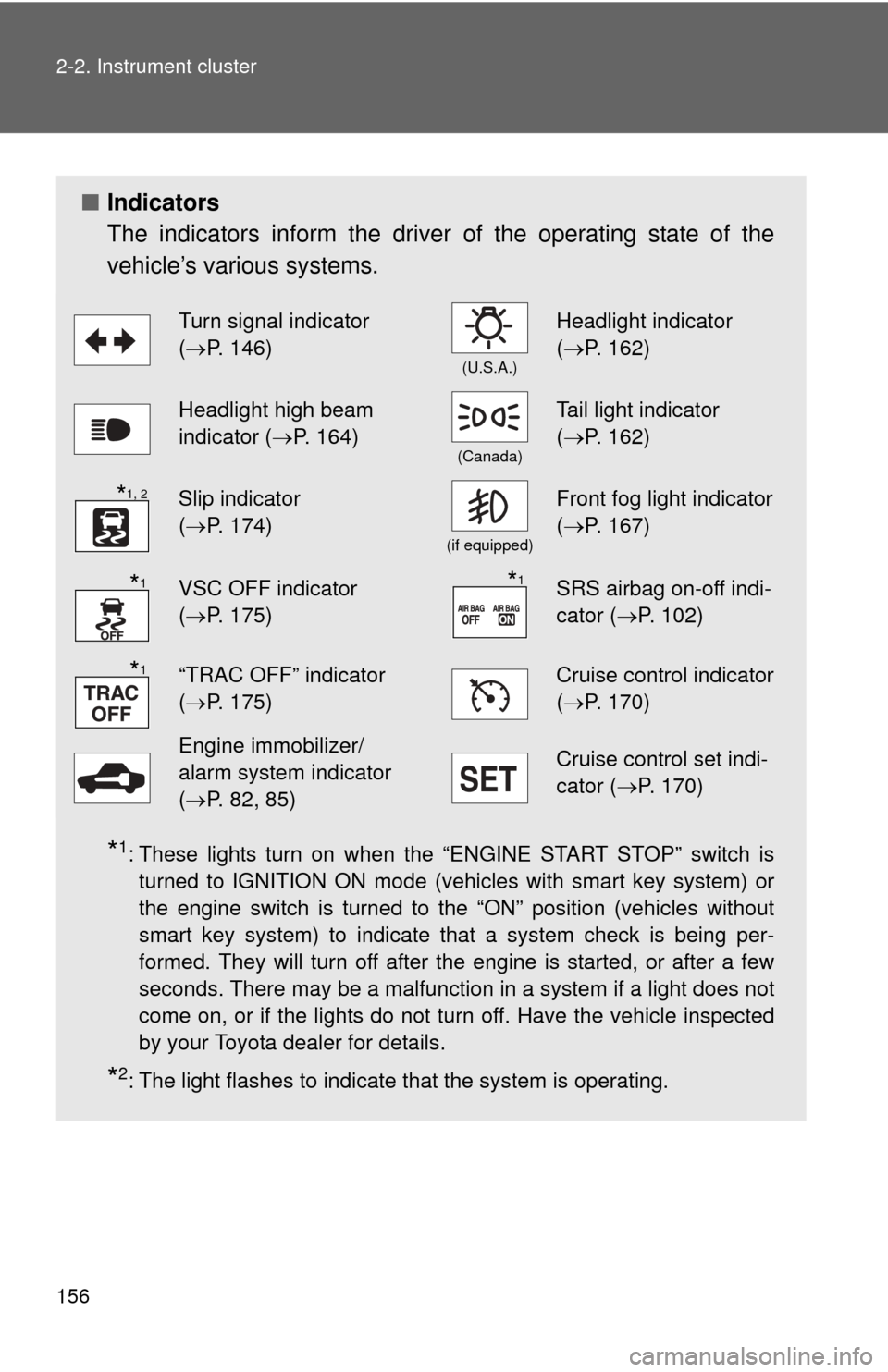
156 2-2. Instrument cluster
■Indicators
The indicators inform the driver of the operating state of the
vehicle’s various systems.
*1: These lights turn on when the “ENGINE START STOP” switch is
turned to IGNITION ON mode (vehicles with smart key system) or
the engine switch is turned to the “ON” position (vehicles without
smart key system) to indicate that a system check is being per-
formed. They will turn off after the engine is started, or after a few
seconds. There may be a malfunction in a system if a light does not
come on, or if the lights do not turn off. Have the vehicle inspected
by your Toyota dealer for details.
*2: The light flashes to indicate that the system is operating.
Turn signal indicator
(P. 146)
(U.S.A.)
Headlight indicator
( P. 162)
Headlight high beam
indicator ( P. 164)
(Canada)
Tail light indicator
(P. 162)
Slip indicator
(P. 174)
(if equipped)
Front fog light indicator
( P. 167)
VSC OFF indicator
(P. 175)SRS airbag on-off indi-
cator (P. 102)
“TRAC OFF” indicator
(P. 175)Cruise control indicator
( P. 170)
Engine immobilizer/
alarm system indicator
(P. 82, 85)Cruise control set indi-
cator (P. 170)
*1, 2
*1*1
*1
Page 167 of 554
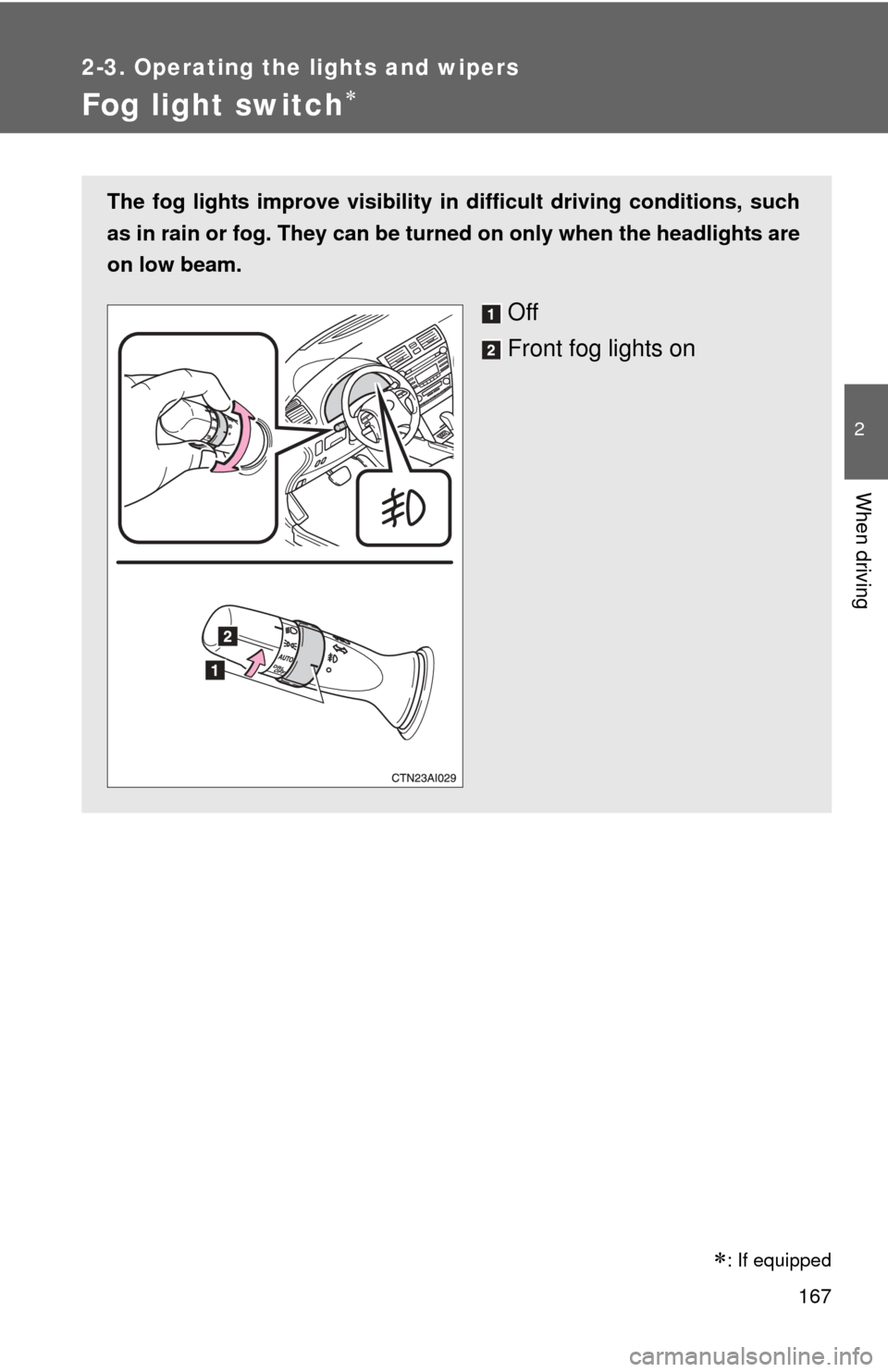
167
2-3. Operating the lights and wipers
2
When driving
Fog light switch
The fog lights improve visibility in difficult driving conditions, such
as in rain or fog. They can be turned on only when the headlights are
on low beam.
Off
Front fog lights on
�
: If equipped
Page 206 of 554
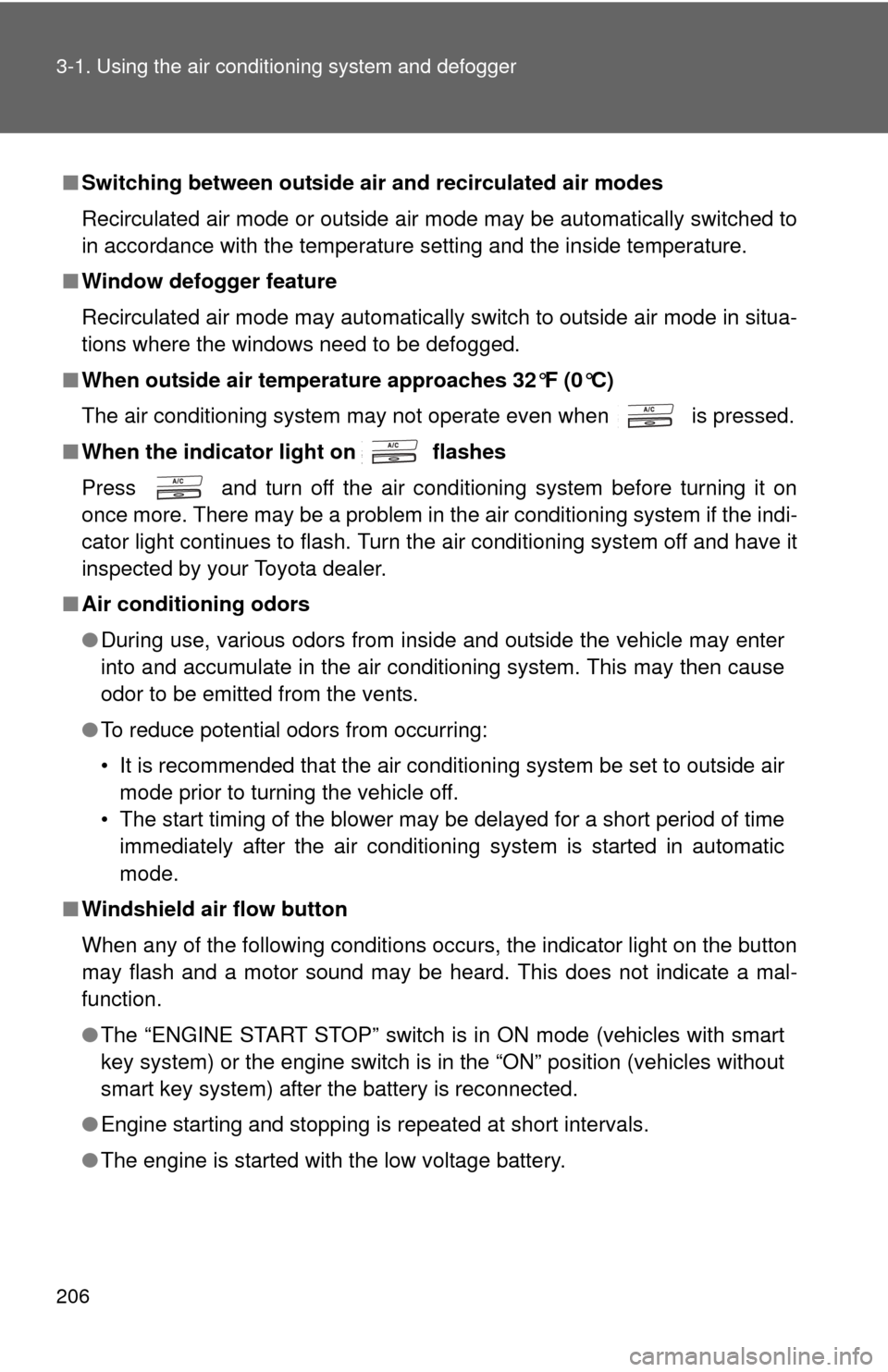
206 3-1. Using the air conditioning system and defogger
■Switching between outside air and recirculated air modes
Recirculated air mode or outside air mode may be automatically switched to
in accordance with the temperature setting and the inside temperature.
■ Window defogger feature
Recirculated air mode may automatically switch to outside air mode in situa-
tions where the windows need to be defogged.
■ When outside air temperat ure approaches 32°F (0°C)
The air conditioning system may not operate even when
is pressed.
■ When the indicator light on
flashes
Press
and turn off the air conditioning system before turning it on
once more. There may be a problem in the air conditioning system if the indi-
cator light continues to flash. Turn the air conditioning system off and have it
inspected by your Toyota dealer.
■ Air conditioning odors
●During use, various odors from inside and outside the vehicle may enter
into and accumulate in the air conditioning system. This may then cause
odor to be emitted from the vents.
● To reduce potential odors from occurring:
• It is recommended that the air conditioning system be set to outside air
mode prior to turning the vehicle off.
• The start timing of the blower may be delayed for a short period of time immediately after the air conditioning system is started in automatic
mode.
■ Windshield air flow button
When any of the following conditions occurs, the indicator light on the button
may flash and a motor sound may be heard. This does not indicate a mal-
function.
●The “ENGINE START STOP” switch is in ON mode (vehicles with smart
key system) or the engine switch is in the “ON” position (vehicles without
smart key system) after the battery is reconnected.
● Engine starting and stopping is repeated at short intervals.
● The engine is started with the low voltage battery.
Page 207 of 554
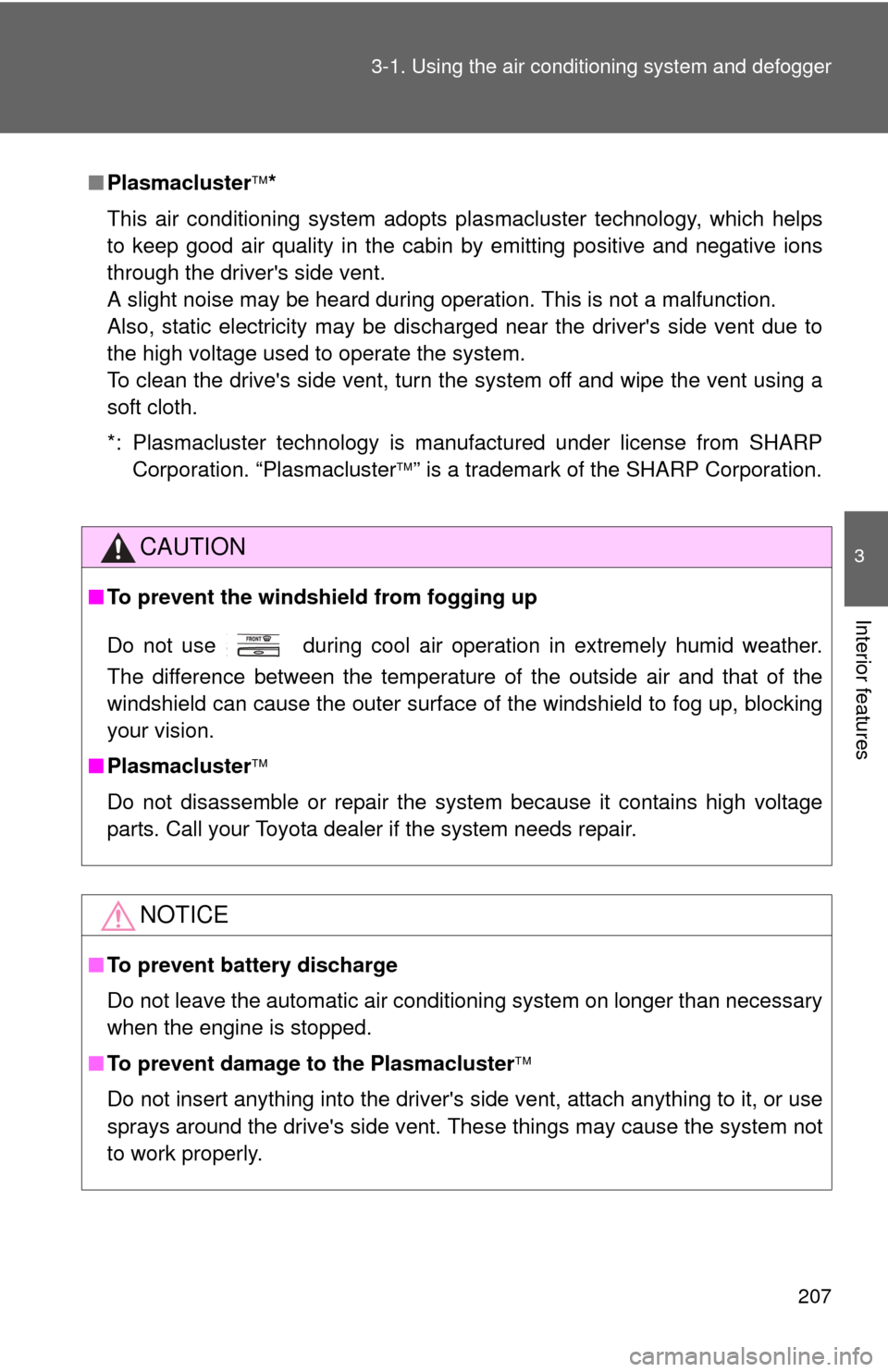
207
3-1. Using the air conditioning system
and defogger
3
Interior features
■Plasmacluster *
This air conditioning system adopts plasmacluster technology, which helps
to keep good air quality in the cabin by emitting positive and negative ions
through the driver's side vent.
A slight noise may be heard during operation. This is not a malfunction.
Also, static electricity may be discharged near the driver's side vent due to
the high voltage used to operate the system.
To clean the drive's side vent, turn the system off and wipe the vent using a
soft cloth.
*: Plasmacluster technology is manufactured under license from SHARP Corporation. “Plasmacluster ” is a trademark of the SHARP Corporation.
CAUTION
■ To prevent the windshield from fogging up
Do not use during cool air operation in extremely humid weather.
The difference between the temperature of the outside air and that of the
windshield can cause the outer surface of the windshield to fog up, blocking
your vision.
■ Plasmacluster
Do not disassemble or repair the system because it contains high voltage
parts. Call your Toyota dealer if the system needs repair.
NOTICE
■ To prevent battery discharge
Do not leave the automatic air conditioning system on longer than necessary
when the engine is stopped.
■ To prevent damage to the Plasmacluster
Do not insert anything into the driver's side vent, attach anything to it, or use
sprays around the drive's side vent. These things may cause the system not
to work properly.